
by Jacques Calero and Sebastián Bianchi
One of the most rare of the Luftwaffe badges, the glider pilot badge was instituted on December 16, 1940. It was awarded to pilots who successfully completed the glider training course.
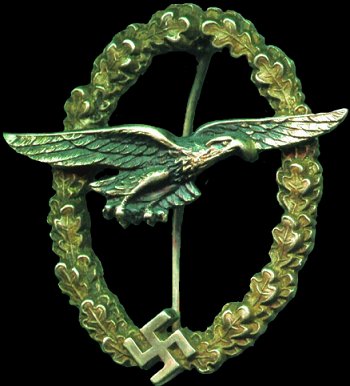
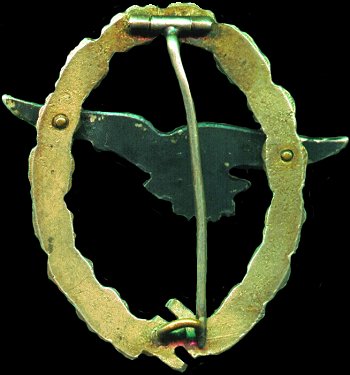
Glider pilot badge undoubtedly manufactured by the firm JUNCKER, without mark, in tombak.
Manufacturing and Technical Information
The badge was compromised of a silvered oak leaves wreath with a swastika at the base. The upper and the lower branches of the swastika may be cut out or solid. A dark oxidized eagle is riveted to the wreath by two tiny round rivet, the eagles' wings are widely spanned with its legs bent close to the body. The claws are generally well detailed and hand finished, and the ridges are burnished.
The fastening system depends on the manufacturer, though it is typically a round barrel hinge soldered to the wreath as with all Luftwaffe badges.
On lower quality Glider Pilot badges there is a hinge and hook attached with soldering plates. The round needle pin and the hook are also soldered to the wreath.
The badge was manufactured in aluminum, nickel-silver alliage, tombak, or zinc.
It seems that a precocious manufacture existed, who built the badge with the same design but with a larger eagle.
The badge was also available in a cloth version (pictured further down the page).

The following is list of known manufacturers :
- C.E.JUNCKER BERLIN
- G.H.OSANG DRESDEN
- W.DEUMER LÜDENSCHEID
- BSW
- No maker mark
Characteristics of an unmarked Juncker type badge:
- Wreath : 55.3 mm X 41.7 mm
- Wreath : 55.3 mm X 41.7 mm
- Cross : 11.4 mm
- Hinge : 12.3 mm X 2.5 mm
- Eagle : 15.1 mm X 52.6 mm

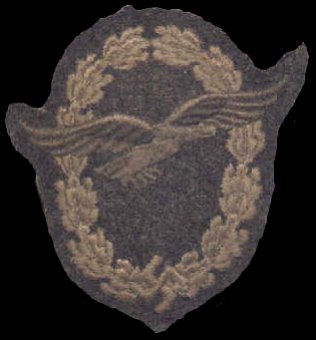
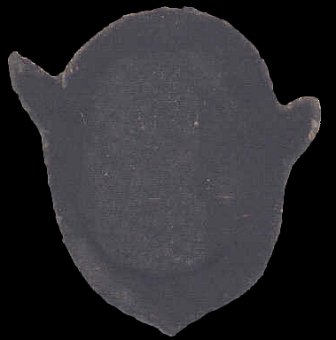
Stijn David Collection
Presentation, Wear, Documents
The badge was presented in a dark blue box whose bottom lid was composed of a blue velvet or blue flocage. The top lid was composed of violet blue silk or blue paper, with the name of the award stenciled in silver on the out part of the top lid.
A certificate was presented to the pilot and the rewarding of the badge was entered in the Soldbuch.
The award was worn on the uniform upper left pocket. Only a few pictures exist showing its wear, one of which may be seen to the right.
Award Criteria and Statistics
The badge was presented to all Glider Pilots who completed the required training course and became certified. Statistics on this badge were unavailable at the time of this writing, if you have any further information on this badge, please contact us at, info@wehrmacht-awards.com.
Knight of the Reich - Feldwebel Willi Schaedler
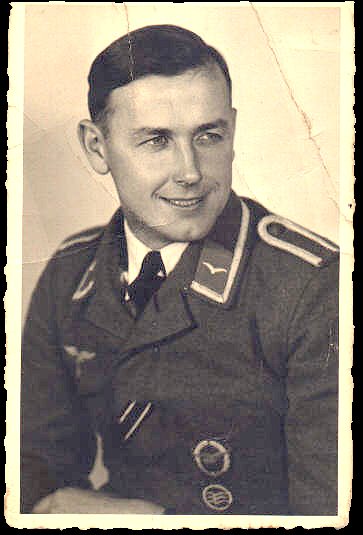
At the time of the Cholm Battle he was still a Gefreiten and as shown on the picture he is a Unteroffizier. You can see here that is wearing the Iron Cross 2nd Class ribbon, and you can also clearly see that he is wearing the cloth version of the Glider's badge.
Unteruffizier Willi Schaedler (born 18.06.1908 Rheindahler ). He was a GO 242 pilot who flew a supply mission into the famous Cholm pocket, landing there on May 2nd, 1942 (the pocket was released on 05/09/1942). The owner of the picture, Stijn David, has a photocopy from his "einsatzbericht " and a official document stating that he was involved in the Cholm pocket battle (he is also mentioned in the book "Diedeutschen Lastenseglerverbände 1937 - 1945"). For his efforts in this battle, he received the Iron Cross Second Class on the day of the release of the pocket, and the Cholm Shield on 10/31/1942. He also qualified for one day of the Infantry Assault Badge.
His decorations were as follows,
- Glider pilots badge : 05.10.1941 (Award document number : 86369 / 41)
- Iron cross 2nd class : 07.05.1942 (Cholm Battle)
- Cholmshield : 31.10.1942
- LW air to ground suport clasp in Bronze : 19.11.1943
- LW ground combat badge : 08.03.1944
His highest rank was Feldwebel ( promoted on 31.05.1944 ) .
It is very interesting to see that he received a Flight clasp (this is highly unusual for a Glider pilot , most of them did never reach this).
He took part in the following battles (page one out off his Flugbuch).
- Training in 1941 Trausitten ( Köningsberg ) , Langendiebach, Eschborn with Lastensegler DFS 230 , later Go 242 in Parchim.
- First mission from Riga in to Cholm , 1942.
- Later that year he transferred to Poltawa and Saporosche, from there "einsatz im gebiet Westlich von Stalingrad " (not in Stalingrad itself).
- At the end off 1943 again a change and transfer to the Kertsch area (Krim), from there missions to the Kubanbrückenkopf (he was encircled for 4 weeks with other troops).
- After this again to bases in Saporosj, Lemberg and Milek (Poland).
- In April 1944 followed the mission to bring supplies to the encircled 1 Panzer-Armee (which he could leave with a small transport plane Fiesler Storch).
- From the base in Milek he transferred again to Buzau (Rumania), Groswardeien, Debrecen ( Hungaria ) , Plattensee (There his unit was disbanded).
- He received a holiday and after this he was to see action with an Infantery Unit (with Marschbattalion 707).
- He was made a prisoner off war on 12/12/1944 by the Americans near Schlestadt (Elzas), 7th Armee , from which he spent 3 years in prison camps.
Picture and information credit - Stijn David
![]()
© Copyright Wehrmacht-Awards.com LLC |